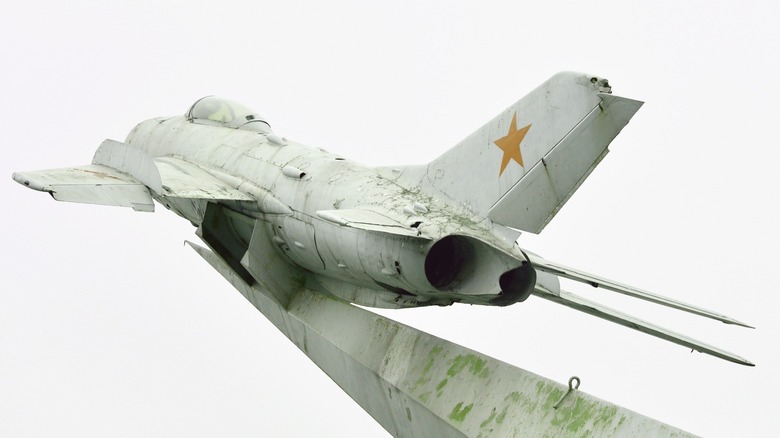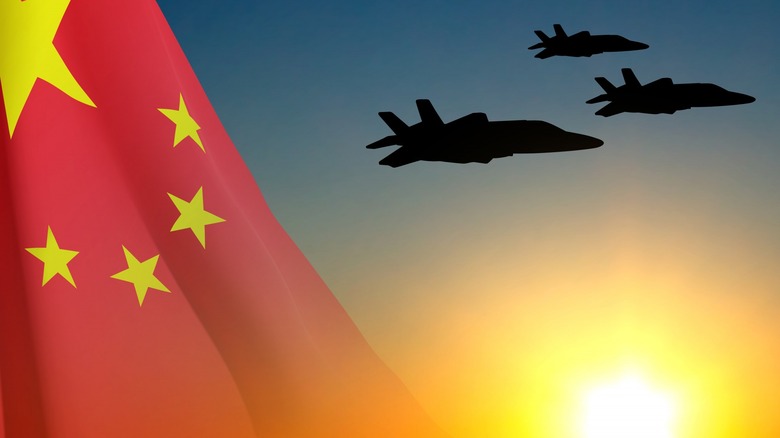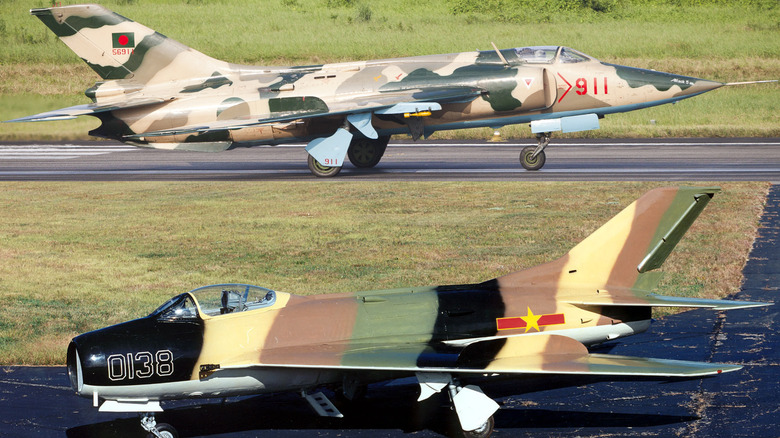How The MIG-19 Inspired China's Nanchang Q-5 Ground Attack Aircraft
With the Cold War in full swing by 1955, three major world powers were pumping out revolutionary aircraft designs at supersonic speeds. The Soviet Union would introduce the MIG-19 twinjet fighter aircraft that very year, only a few months after the United States first took to the skies with the North American F-100 Super Sabre. The two planes were extremely similar in power and design, highlighting the razor-thin margin between the superpowers' arms race. But in the Far East, China was vying for its spot on the world stage with its own version.
China's Nanchang Q-5 fighter was introduced in 1970, and countries in conflict began buying it up in droves. Like its competitors, it had one seat, powerful twin jet engines, an array of the latest radar technology, and the capability to carry a nuclear warhead over great distances. Variants were sold to North Korea, Myanmar, Bangladesh, and Pakistan.
The Q-5 was clearly based on the MIG-19. Yet, the MIG-19 preceded the Q-5 by almost 15 years, and it sports nearly the same specs and power. In fact, the MIG-19 is faster than the Q-5 at high altitudes, with a maximum speed of about 900mph compared to the Chinese jet's speed cap of about 750mph. So why is the Chinese craft still in active service while the Soviet MIG-19 rests in Russian retirement?
The People's Republic of China and their love of the Soviet MIG-19
During the Vietnam War, the MIG-19 failed to deliver on its high price tag. Analyzing its reception at the time, Michael Peck of The National Interest observes, "Intensive maintenance requirements and difficult handling characteristics proved unpopular with the Soviets and many of their allies, such as North Vietnam." Yet, China had a different opinion. Peck writes, "Strangely, China proved quite fond of the MIG-19."
China bought hundreds of MIG-19s and even had its own production facility. It's almost certain that China wasn't just buying and building the MIG-19 for combat service. At the time, the People's Liberation Army Air Force's best home designs couldn't match the speed and low-altitude performance of the MIG-19. Many other countries were also relying on the MIG-19's superior engineering, such as North Korea where it's still used today.
With conflicts in Vietnam, Thailand, and Taiwan raging in the mid-20th century, the PRC needed something highly maneuverable for ground attacks and close air support. The MIG-19 was the perfect model. Plus, if China could get its name on a modern supersonic jet (albeit one that "borrowed" its tech from Soviet engineers), it would be a symbol of its global power.
The Chinese Q-5 compared the Soviet MIG-19
The similar specs reveal the extent of the MIG-19's influence on the Q-5. The Chinese fighter's biggest upgrade was an overhaul of the fuselage, with an extended length of 15.65m and new positioning of the guns and air intakes. It also adopted two turbojet engines with 31.87kN of after-burner thrust matching that of the MIG-19.
The MIG-19 is shorter, at 12.5m, but its wingspan of 9m is almost equal to the Q-5's 9.68m wingspan. According to the Area Rule of aero engineering, "Airplanes with the same longitudinal cross-sectional area distribution have the same wave drag, independent of how the area is distributed laterally." Because the MIG-19 and Q-5 measure closely in this regard, they experience nearly the same amount of wave drag. As a result, both planes have the same maximum speeds at low altitudes.
Though the inspiration is indisputable, there are a few discrepancies. For instance, the Q-5 has a fuel capacity of 2883kg, while the MIG-19 tops out at about 1,800kg. This exemplifies the intended use of the Q-5, as its close-combat maneuvers require huge amounts of fuel. The MIG-19 is better equipped for higher altitudes, and it can cruise with greater fuel efficiency.
The similar specs and a side-by-side comparison of the two designs reveal the extent of the MIG-19's influence on the Q-5. Russia has since retired the MIG-19, and only a handful of countries use it to this day (making it one of the oldest aircraft in service). The Q-5, however, still flies with a Chinese flag. Indeed, the Soviet-inspired aircraft continues to serve as a sky-high testament to the terrible and awesome innovations of a global arms race.
[Top featured image by Faisal Akram via Wikimedia Commons | Cropped and scaled | CC BY 2.0]
[Bottom featured image by US Air Force via National Museum of the US Air Force | Cropped and scaled | Public Domain by Title 17 of the US Code]


